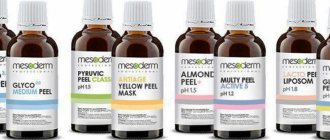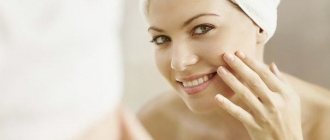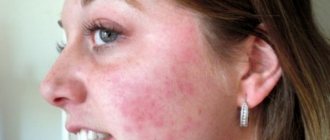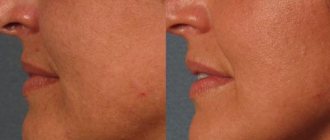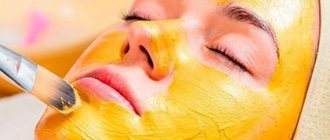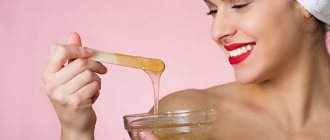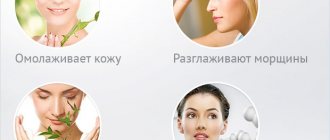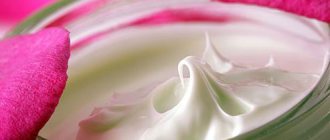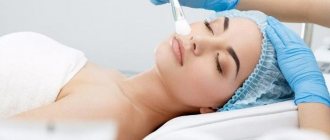Chemical peels have long become a popular method of combating various skin imperfections: acne and post-acne, sun spots, wrinkles, uneven skin tone and texture. During their implementation, various acids, solutions or phenol are used. The chemical is applied to the skin and removed after some time. As a result, the top layer of skin peels off, revealing a younger, more intact layer. The best time for peeling is considered to be late autumn and winter. This time of year there is little ultraviolet radiation from the sun, which can damage the skin by causing increased pigmentation in treated areas. And since winter in cosmetology ends in March, we have time to jump into the last carriage and attend several procedures. How not to get lost among the many types of peeling, what contraindications exist, and how the skin is restored, we will tell you in our review.
Photo from www.safrica24.com
Salicylic peeling
Often the first peeling that cosmetologists recommend is salicylic peeling.
It has been used in cosmetology for a long time, but it has not lost its relevance. As the name implies, it uses salicylic or phenolic acid, which helps the skin completely get rid of dead epidermal cells. There are two types of salicylic peeling: superficial, which uses a 15% solution of phenolic acid, and mid-superficial using a 30% solution of the substance. The first option has a gentle, light effect, while the second penetrates more deeply, smoothing out the skin texture. Salicylic peeling involves burning the surface layer of the skin and leads to its exfoliation. Therefore, you should trust your face only to an experienced cosmetologist. Before the procedure, the skin is thoroughly cleansed and excess fat is removed. Then a solution of salicylic acid is applied and, if necessary, a neutralizing agent is used. During the recovery period, which takes 7-10 days, the skin may turn red and peel, which is completely normal after exposure to acid. The main thing is to refrain from removing exfoliating particles from your face yourself.
— I peeled every week, a total of 4 times.
In general, I want to say that this is a good thing: the pores become narrower, the face seems fresher, the pimples that exist are dried out, and the skin color itself is smoothed out. But unfortunately, the solution to the acne problem did not help,” one girl shared on the forum after a visit to a cosmetologist. Another client was more satisfied with the procedure:
— What we have as a result, 7 days after use: improved complexion, more even tone, skin texture after post-acne is much smoother, the pits have evened out (but I needed 3 more peeling procedures to get rid of the pits completely, I think that’s what standing, the pits were shallow), the disappearance of the subcutaneous skin, post-acne spots became noticeably lighter.
When peeling, salicylic acid suppresses the activity of the sebaceous and sweat glands, has a vasoconstrictor effect, and relieves skin itching. The product exfoliates dead skin particles, cleanses pores of impurities and sebum. The acid also dries out inflamed areas, lightens acne marks and age spots, kills bacteria and dissolves comedones. Contraindications for the procedure are individual intolerance to the drug, multiple rashes, spider veins, herpes, pregnancy and breastfeeding.
Prevention of post-peeling complications
- The main direction in preventing possible complications is the understanding that you are carrying out the procedure not under the influence of fashion trends, but only in case of real need.
- The next step should be an adequate choice of peeling. The depth of exfoliation is determined by taking into account many factors, which include:
- season;
- severity of defects;
- general skin condition;
- taking medications that affect the characteristics of the epidermis.
- Another point in preventing complications will be to ensure that your chosen specialist fully informs you. He is obliged to provide complete information about everything related to:
- procedures, including the occurrence of possible side effects;
- the effectiveness of the process being performed;
- money spent on rehabilitation;
- possibility of correction of complications.
- But the main prevention of post-peeling complications will be compliance with technology at all stages of the procedure.
During the skin maintenance stage, in the period following exfoliation, do not use products with high levels of mineral oils. They significantly increase the temperature of the epidermis, which leads to inhibition of healing and promotes the proliferation of bacteria.
By carefully following all the points of pre-peeling preparation, you can achieve not only excellent results from the procedure itself, but also significantly reduce the risk of undesirable consequences.
Jessner Peel
The most effective procedures for combating skin problems include Jessner peeling. The composition was invented by the American Max Jessner. He decided to use a mixture of salicylic, lactic acid and resorcinol for exfoliating procedures.
The combination of acids and antiseptics turned out to be effective. In a short period of time, the Jessner procedure optimally moisturizes the epidermis, improves skin color and texture, and reduces defects such as pigmentation and small scars. Peeling also has a rejuvenating effect. Lactic acid makes the skin soft, activates collagen synthesis, moisturizes the skin and stimulates cell renewal. Salicylic acid penetrates the pores, removes sebum, and exfoliates the stratum corneum of the dermis. Resorcinol kills pathogenic bacteria or fungi.
The procedure is recommended for acne, enlarged pores, hyperpigmentation, expression lines, hyperkeratosis, scars and freckles. Based on the degree of penetration into the skin layers, Jessner peeling is divided into superficial, medium and deep. Depending on this, the number of layers varies.
Before the procedure, home preparation is required. The skin is wiped with lotion with fruit acids for about two weeks. The peeling itself is carried out only in the salon by experienced cosmetologists, and deep peeling is carried out only by a doctor. Oil-free skin is wiped with the active composition, and then a soothing mask is applied.
The recovery period may not be the most pleasant and a little scary. It takes from 5 days for superficial peeling to 20 days for deep peeling. Immediately after the procedure, the face turns red, and the next day it becomes brown and covered with a film. You cannot remove the film yourself; it falls off on its own after 3-4 days.
— After Jessner, the skin comes off significantly
, users on the Internet note,
“it is really qualitatively renewed throughout the entire face, while after superficial peeling the skin comes off slightly and in small particles.
The skin was completely renewed in a fairly quick time. This may appeal to those who want to get rid of dull skin color, post-acne, and blemishes. The microrelief of the skin has become more even, smooth and delicate, bumps and enlarged pores have disappeared. Small expression wrinkles on the forehead and in the smile area have been smoothed out. The skin has become cleaner and brighter. To obtain a lasting effect, it is recommended to take a course of 6-8 sessions. Contraindications for Jessner peeling are herpes, purulent skin diseases, diabetes, pregnancy, many moles, oncology, autoimmune diseases.
Scrub mask recipes
Peeling can be done with ready-made cosmetic scrub masks purchased in a store or pharmacy, or home-made.
The most effective and popular recipes for such masks prepared according to folk recipes:
1. mix baking soda and finely ground salt, taken in equal parts, apply to prepared skin along with soap foam. It is effective to use shaving foam as soap foam; its antibacterial components will have an additional cleansing effect;
2. dried bodyaga crushed in a coffee grinder, steamed with boiling water and mixed with apple cider vinegar or 3% hydrogen peroxide until a soft paste forms;
3. any cereal, crushed in a coffee grinder and mixed with kefir or sour cream;
4. coffee grounds from natural coffee mixed with diluted brewer's yeast.
In cleansing the skin, the main thing is not the quantity and variety of scrubs, but the regularity of use, so you need to choose one or two recipes you like. It would be enough.
Scrubs are applied with massage circular movements, left for ten minutes and rinsed off with warm water.
Glycolic peeling
This is the name of a superficial chemical peel, which is based on glycolic acid. This treatment is said to be suitable for all skin types. It is just not recommended for people under 15 years of age. The glycolic acid molecule easily penetrates the skin, moisturizing it. This peeling also has antioxidant properties and activates the production of collagen, elastin and other beneficial compounds. As a result, healthy skin color is restored, its texture is reduced, and fine wrinkles can be completely smoothed out.
Cosmetologists recommend glycolic peeling as a preparation for other cosmetic procedures, for pigmentation, grayness or uneven skin, as a means of combating acne and small wrinkles. You should make an appointment with a cosmetologist two weeks before the procedure itself to ensure good preparation. This will help avoid unpleasant consequences. Typically the course ranges from 4 to 10 sessions depending on the condition of the face and the desired result.
First, the specialist wipes the skin with a weak solution of glycolic acid to soften and degrease. Then glycol gel is evenly applied for a few minutes and removed with a special neutralizing solution. Many patients choose glycolic peels for their comfort. During the procedure, a person does not experience any unpleasant sensations, which is typical for other types of peeling. Sometimes there is a slight burning sensation, but it goes away easily if you direct a stream of cold air.
As with other peels, the results will not appear immediately. Before this, not the most pleasant consequences may arise. Redness of the skin may last from 2 hours to several days. Very sensitive skin will develop crusting or swelling. In these cases, only a cosmetologist will help, who will select a suitable moisturizer. Removing the crust on your own can lead to scarring. Do not do that!
— Throughout the week, my skin did not peel. She became cleaner, her tone evened out, she literally began to shine,
— users on the Internet speak about glycolic peeling.
And here is another review:
- The course of peelings took me a month. Scars and scars after squeezing out pimples became less noticeable. You can even say that they have resolved. Small wrinkles have disappeared. Pigmentation has decreased significantly. The oiliness of the facial skin has also decreased. Improved skin condition: tone, elasticity, smoothness, fresh look. Alas, in my case, this peeling did not affect acne and enlarged pores. To sum it up, glycolic acid peels actually give good results. It is very important to follow all the recommendations of the cosmetologist. And never neglect sunscreen!
Acids? They exfoliate, rejuvenate and make your skin beautiful!
Acid treatments are a great treatment for people who want to refresh their skin after summer, reduce acne scars, seborrhea, blackheads, pigmentation changes or fine lines around the eyes and mouth. If you want your skin to become firmer, smoother, more radiant and have a youthful, healthy appearance, schedule a visit today and book an acid peel at our beauty clinic.
Remember that regular exfoliation helps keep your skin in good condition and normalize its condition. Peelings are a great way to prevent aging!
Phformula
The PH-formula procedure is called a new generation peeling. It stimulates cellular regeneration, destroys damaged cells, renews the skin, increases the synthesis of collagen and glycosaminoglycan in the dermis. At the same time, skin injuries and irritation are reduced to a minimum. The pHformula line includes alpha-keto, alpha-hydroxy, alpha-beta and poly-hydroxy acids. This combination has a less traumatic effect than products based on a single acid in high concentration.
In addition to acids, this peeling contains substances for skin restoration: antioxidants, vitamins, microelements, oxygen carriers, metabolizers. These components allow the skin to recover faster after peeling and reduce the likelihood of complications.
The development of Spanish specialists is effective in the fight against acne, rosacea, wrinkles and pigmentation. Peeling has a gentle effect on the skin, causing peeling to quickly give way to regeneration. At the same time, the cosmetologist can control the duration and intensity of the composition’s action.
PROFESSIONAL PREPARATION TOOLS
For those who are looking for something to degrease the skin after peeling or prepare it for chemical or mechanical exfoliation, it is better to opt for professional products specially developed for this purpose.
Cleaning emulsion
Deep-pore-cleansing emulsion from the French manufacturer BEAUTYMED is suitable for gentle preparation for chemical peeling. Prevents dehydration, irritation, refreshes.
We recommend: PEELING AND DEMODECOSIS: getting rid of unnecessary roommates
Anti-aging toner with amino acids and collagen
A tonic and biostimulating product from the Russian brand CORA rejuvenates, soothes and moisturizes, evens out the complexion, adds radiance, relieves swelling, and prepares the skin for a deeper perception of active ingredients.
Aloe gel with geranium oil
A drug from the CHARMCLEO COSMETIC brand (Russia) helps prepare for mechanical cleaning, opens the sebaceous ducts, cools and provides hydrogenation without steaming. Can be used as a soothing moisturizing mask.
Milk peeling
Milk peeling is becoming increasingly popular due to its gentle action compared to other types of deep chemical peeling. At the same time, it produces a visible effect. The peeling agent is based on lactic acid in a concentration of 80-90%. The product penetrates the skin and gently cleanses it of dead cells, which peel off within a week after the procedure. Peeling also activates collagen production. This is a kind of shock for the skin, after which it begins to restore itself.
As a result, the skin texture is evened out, a blush appears, a slight lifting effect is achieved, sebum secretion is regulated, and pores are narrowed. In addition to exfoliation, milk peeling also deeply moisturizes the skin and increases its elasticity. The production of collagen and elastin is activated. The procedure gets rid of acne marks and the acne itself. Whitens, brightens and has an anti-inflammatory effect.
Contraindications to such peeling may be individual intolerance to the components, skin diseases, dermatitis, herpes, diabetes, pregnancy and lactation, oncology, skin wounds, fresh tan. Milk peeling is superficial, so the risks of unwanted side effects are very small, but they still exist. Allergies are possible if the allergy test is neglected. If you use a low-quality product, burns may occur.
— In general, I can say that the skin of the face becomes smoother in both texture and color. You just need to be patient to walk around with a flaky and oily face from cream (since you can’t use powder and other things), then destroy all the rashes that were inside and came out, polish it with another (minimum) peeling, and that’s it - voila - beautiful and renewed skin will delight you every day! —
Those who have tried milk peeling share their experiences.
What should you not do before the procedure?
In order for the procedure to go smoothly, with maximum effect, and to have no side effects, it is necessary to clearly understand what actions are strictly prohibited before starting it.
Visit the swimming pool and solarium
Before exfoliation, you should never visit a solarium or swimming pool. If superficial peeling is planned, then it is necessary to limit visits to places where artificial tanning services are provided 2-3 days before the appointed date.
If you are planning to carry out a deep tissue cleansing, then the period of refusal from the solarium increases to a month. After all, a shorter time will lead to the fact that the entire effect of visiting a solarium will simply be destroyed. In addition, reducing melanin synthesis helps prevent the formation of age spots on the skin.
When visiting a bathhouse, the body experiences increased temperature stress , as a result of which profuse sweating begins.
This may contribute to severe skin irritation in the event of a subsequent peeling procedure. This can even lead to a 1st degree thermal burn.
Laser and wax hair removal is prohibited
After depilation, the mouth of the follicle remains open for up to 2 days. If you do exfoliation immediately after removing unwanted hair, it is possible to trigger the development of a serious complication - folliculitis. This pathology is an infection of the hair follicles. The main danger is that this disease can often develop into a chronic stage.
At least 4 days before peeling, you should stop depilating. In order not to have an additional effect on the skin that is in a stressful situation. Any mechanical damage, or even friction, is prohibited.
After peeling
After any peeling, it is necessary to protect the skin from ultraviolet radiation, which can cause pigmentation. Before going outside, it is important to use creams with SPF factor. In the city, 10 or 15 SPF is enough. If you are going to a different climate zone, then SPF protection should be higher - 30-50. There are many more types of peeling, and this review could be endless. The main advice is to choose a professional, trusted cosmetologist. A specialist will assess the condition of your skin, competently select an effective peeling specifically for you, and advise the correct care after the procedure. Take care of your health and be beautiful!
GENERAL ALGORITHM FROM A COSMETOLOGIST
Regardless of what type of exfoliation is planned, you should first contact a specialist. Choosing the right cosmetologist is especially important for beginners. He will assess the condition of the skin, determine contraindications and recommend care. However, there are universal tips that you need to follow when preparing for peeling.
We recommend: ENZYMATIVE PEELING: how it borrows rejuvenation techniques from pineapple
To begin with, you should pay attention to the vessels. How deep the intervention can be carried out depends on their proximity to the surface and the thickness of the cover itself. In addition, it is important to determine which drugs cause allergies in order to prevent rashes and irritations after contact with them.
Preparations begin 2 or 3 weeks in advance. During this period, it is worth postponing visits to the bathhouse, solarium, and swimming pool. In addition, the use of certain antibiotics is limited. It is also recommended to refrain from smoking and drinking alcoholic beverages.
How to choose a peel according to your skin type
The skin's reaction to peeling depends on its type:
- For sensitive epidermis, light exfoliants are recommended that do not affect the deep layers of the epidermis (fruit, vacuum cleaning, gas-liquid method). The exfoliation process in this case should lead to accelerated cell regeneration and a decrease in sensitivity. It is advisable to choose a course of sessions with frequent but superficial treatment.
- The problem type should first determine contraindications: for example, open inflammations, which should first be eliminated. Methods such as cleaning with vacuum devices, laser or ultrasound are suitable.
- For mixed types, it is better to choose deep methods, but with a gentle composition. Therefore, hardware peeling, local mechanical cleansing, enzyme and peptide cleansing are ideal for combination skin.
- For oily skin types, exfoliation should include drying and dissolving components that will help regulate sebum production. To get rid of oily shine, it is recommended to pay attention to chemical and mechanical cleaning.
- Ultrasonic, mechanical or aqua peeling is recommended for normal skin
- For dry types, exfoliation with liquid nitrogen and chemical exfoliation is suitable.
